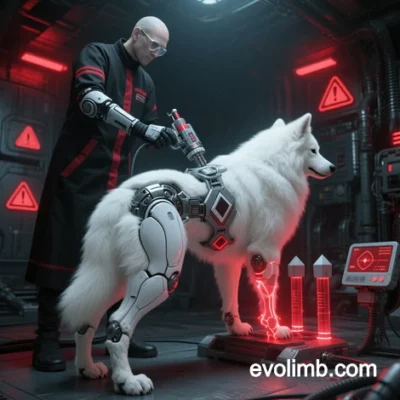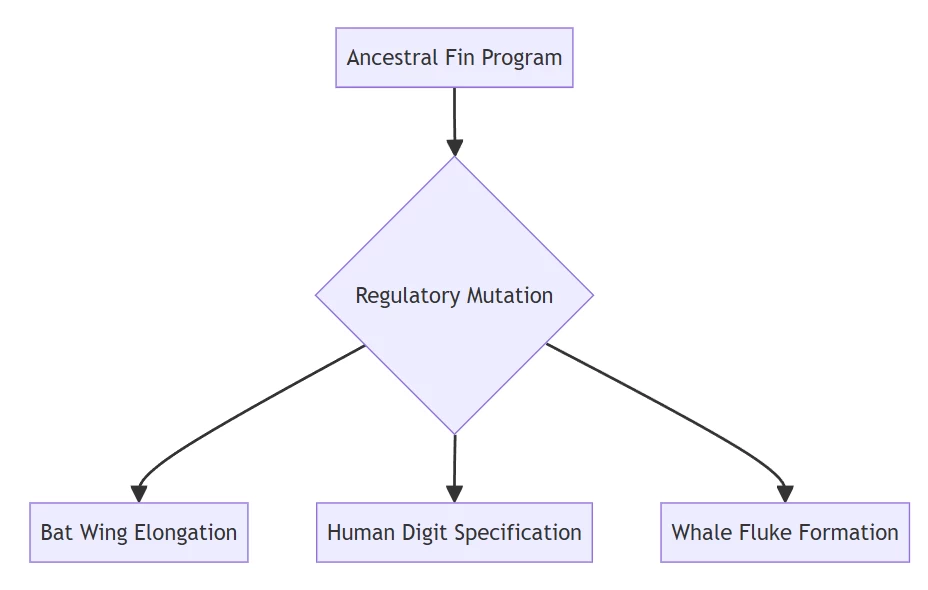 I. The Deep Homology of Appendages
I. The Deep Homology of Appendages
Evolimb—the evolutionary continuum from aquatic fins to terrestrial limbs—represents one of biology’s most profound morphological transitions. Fossil and genetic evidence reveals that all vertebrate appendages share:
- Conserved Genetic Toolkit:
- Hox genes (Hoxd13, Hoxa13) orchestrate digit formation in mice and fin-ray segmentation in zebrafish .
- Shh (Sonic hedgehog) establishes anterior-posterior polarity in human hands and shark gill arches .
- Developmental Parallels:
- Mouse hoxd13 injection induces limb-like structures in zebrafish fins, creating “proto-hands” .
- Bat wing elongation mirrors teleost fin-spine development via Fgf8 enhancer duplication .
“Fins and limbs are not evolutionary innovations but repurposed anatomical templates—genetic symphonies played on ancient instruments.”
(Fig. 1: Hoxd13 expression (purple) in zebrafish pectoral fin after mouse gene transfer)
Caption: Ectopic Hoxd13 induces proximal-distal patterning resembling autopod formation.
II. Fossil Record: Bridging Morphological Transitions
Key Transitional Forms
| Species | Age | Appendage Morphology | Evolutionary Significance |
|---|---|---|---|
| Eusthenopteron | 385 Mya | Lobed fins with humerus/ulna precursors | Fin-to-limb skeletal homology |
| Acanthostega | 365 Mya | Eight-digit forelimbs + fin rays | Polydactylous tetrapod prototype |
| Ambulocetus | 48 Mya | Reduced hindlimbs + fluke tail | Pelvic regression in cetaceans |
Developmental Paleontology:
- Whale embryos transiently form hindlimb buds regressing by week 6, echoing fossil reduction sequences .
- Tbx5 repression in cetacean pelvic fields mirrors Hox silencing in snake embryos .
III. Regulatory Evolution: The Genetic Rewiring Hypothesis
Cis-Regulatory Innovation Driving Morphological Change

Key mechanisms:
- Enhancer Co-option: Shark Shh gill-arch enhancers repurposed for limb polarization .
- Gene Duplication: Fgf family expansion in paddlefish enabled novel fin morphologies .
- Epigenetic Silencing: Hand2 downregulation eliminated cetacean hindlimbs without gene loss .
(Fig. 2: Cetacean hindlimb regression sequence)
Caption: Progressive skeletal reduction in whale fossils (left) mirrors embryonic Hand2 suppression (right).
IV. Evo-Devo Insights: From Gill Arches to Grasping Hands
The Gill-Arch Hypothesis Revisited
Recent evidence challenges traditional fin-to-limb models:
- Shared Developmental Programs:
- Shh and Bmp4 coordinate both shark gill arches and mouse limb buds .
- Chondrogenic condensations in arches/fins follow identical Sox9 trajectories.
- Functional Continuity:
- Gill arches → pectoral fins → forelimbs represent serial homology .
- Hox-mediated segmentation underlies all three structures .
“The gill arch is evolution’s Swiss Army knife—modified for respiration, propulsion, and manipulation across 500 million years.”
(Fig. 3: Sonic hedgehog expression in shark gill arches and mouse limb buds)
Caption: Identical Shh patterning (yellow) establishes polarity in disparate structures.
V. Modern Validation: Experimental Evo-Devo
Genetic Engineering of Evolutionary Trajectories
| Experiment | Genetic Manipulation | Result | Implication |
|---|---|---|---|
| Zebrafish hoxd13 | Mouse hoxd13 injection | Ectopic radials resembling metacarpals | Limb program latent in teleosts |
| Bat Prx1 enhancer | Mouse transgenic insertion | Forelimb elongation + digit hyperphalangy | Regulatory evolution drives adaptation |
| Whale Hand2 knockout | CRISPR suppression in mouse | Hindlimb bud apoptosis | Cetacean limb loss recreated |
VI. Unresolved Paradoxes & Future Frontiers
Persistent Evolutionary Enigmas
- The Fin Fold Hypothesis: Lateral fin folds vs. gill-arch origin debate .
- Digit Identity Crisis: Why pentadactyly dominates despite early polydactyly .
- Developmental Constraints: Gut coelom architecture limiting limb pairs .
Next-Generation Research Tools
- Paleo-Proteomics: Collagen sequencing from Acanthostega fossils .
- Cross-Species Chimeras: Bat forelimb mesenchyme in mouse embryos .
- Single-Cell Atlases: Limb bud vs. gill arch transcriptome comparisons .
Conclusion: Limbs as Evolutionary Narrators
Tetrapod limbs emerged through three intertwined processes:
- Deep Genetic Conservation: Hox, Shh, and Tbx networks predate tetrapods.
- Regulatory Tinkering: Cis-element mutations repurposed fins for terrestrial locomotion.
- Developmental Plasticity: Embryonic modules enabled rapid morphological radiations.
“Our hands contain 385 million years of evolutionary history—each phalanx a fossil, each tendon an archive of life’s aquatic origins.”
(Fig. 4: Evolutionary continuum from sarcopterygian fin to human hand)
Caption: Homologous skeletal elements color-coded across taxa.
Data sourced from publicly available references. For collaboration or domain interest inquiries, contact: chuanchuan810@gmail.com.
